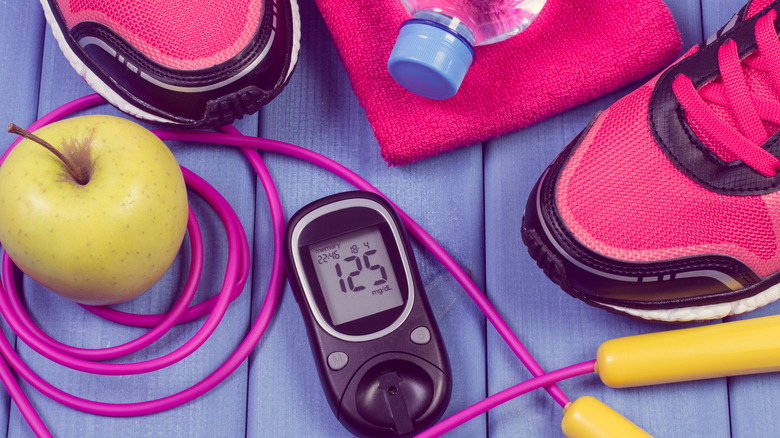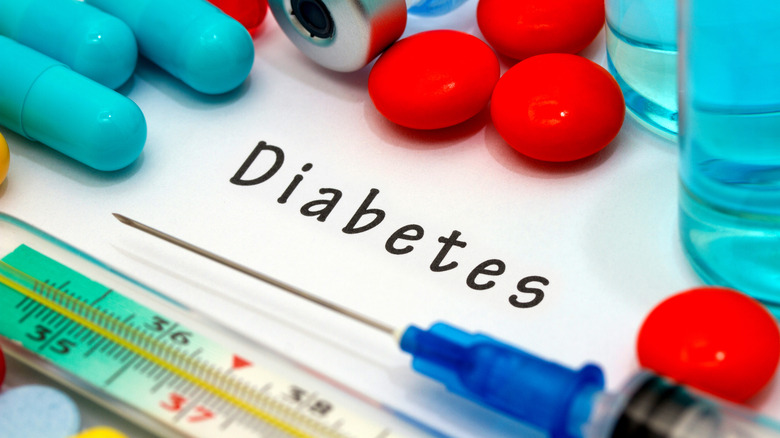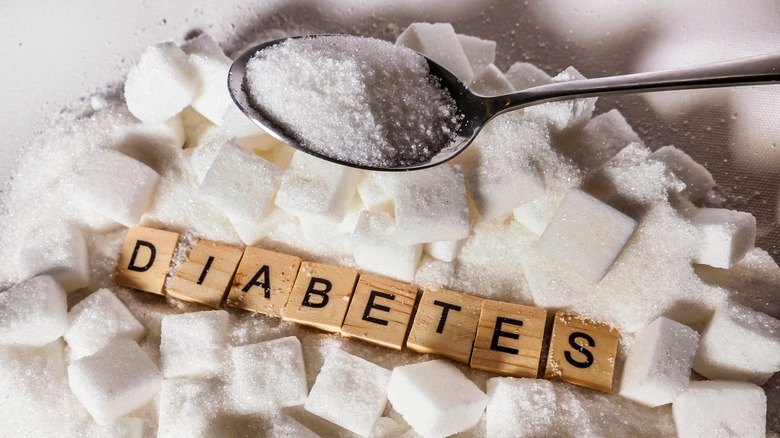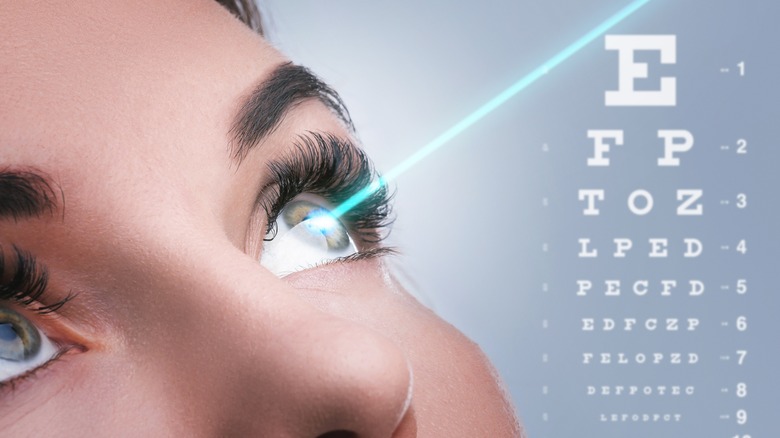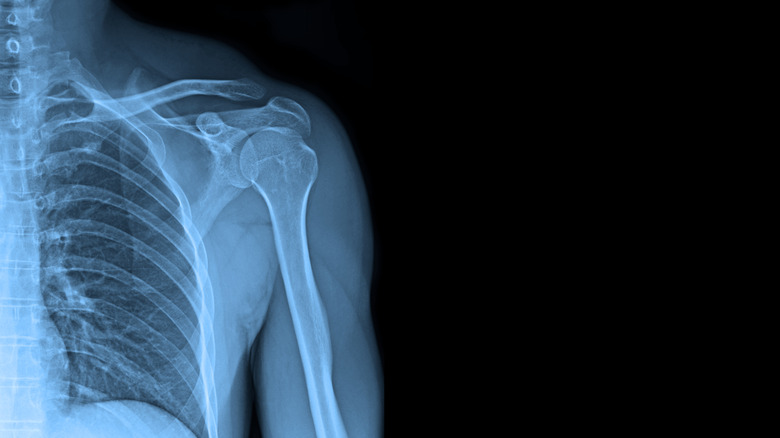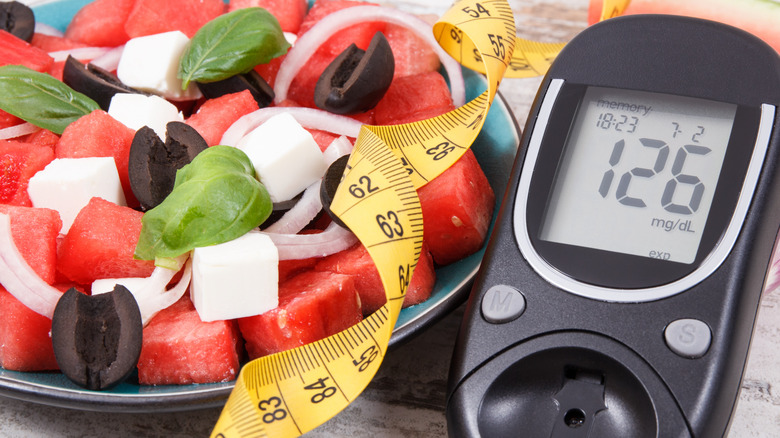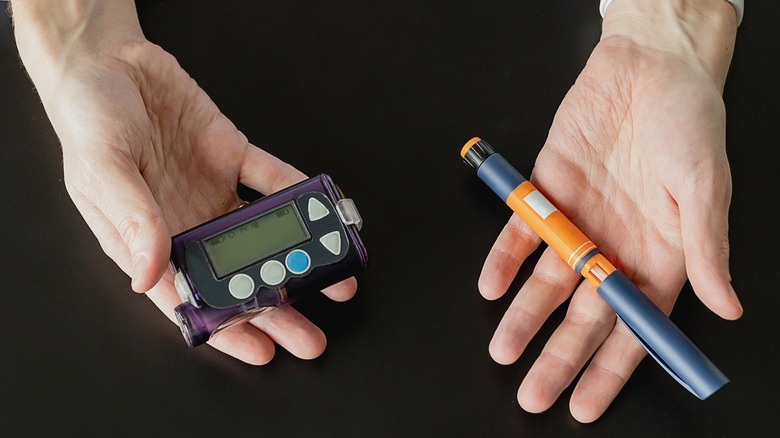Things You Never Knew About Type 2 Diabetes
A major source of energy for your body is a type of sugar called glucose, which comes from the food you eat (via Mayo Clinic). Glucose goes through your bloodstream and enters your cells with the help of a hormone created by the pancreas: insulin. Any excess glucose gets stored in your liver.
Type 2 diabetes results from your body not using insulin sufficiently. When this occurs, your body tries to fix the difference by making more insulin. However, if a balance is not met, you end up with too much glucose in your bloodstream (via MedlinePlus).
Of the nearly 40 million people with diabetes, over seven million have no idea they have the disease. Regardless of whether they've been properly diagnosed or not, at least 90% of those with the illness have type 2 diabetes, according to the Centers for Disease Control and Prevention (CDC). Both genetics and lifestyle play a role in whether or not you will develop diabetes. One significant risk factor is being overweight and carrying it in your stomach (via Healthline). Additionally, race and ethnicity also play a role (via Mayo Clinic).
Difference between type 1 and type 2
There are several different types of diabetes. The most commonly diagnosed are type 1 diabetes (T1D), type 2 diabetes (T2D), and gestational diabetes, which occurs during pregnancy (via GoodRx).
T1D and T2D result from the body's inability to use insulin properly. T1D is caused by the body attacking the pancreas, making it unable to produce the insulin needed. People with T2D have a pancreas that doesn't produce enough insulin to keep up with what the body requires (via Medical News Today). Genetic predisposition appears to be a significant risk factor for T1D, which affects less than 10% of those diagnosed with diabetes and usually appears early in life (via Diabetes UK). T2D mainly results from lifestyle choices and tends to develop over time.
Though the symptoms of both types of diabetes are similar, those related to T1D appear more quickly than with T2D. In fact, the same problems that occur over weeks for someone with T1D can take years to develop in a person with T2D (via Medical News Today).
Prediabetes
More than 80% of the nearly 100 million adults in the U.S. with prediabetes are unaware that they have the condition, because few symptoms accompany the health issue (via CDC). Prediabetes results from higher-than-normal blood sugar levels. Normal blood glucose levels fall between 70 mg/dL and 99 mg/dL. Those with prediabetes have blood glucose levels between 110 mg/dL and 125 mg/dL (via Prediabetes).
Your risk for developing prediabetes rises with age, and it is most often diagnosed in those over 45 (via Cleveland Clinic). In addition, if you have an immediate family member with T2D, you are more likely to develop prediabetes. The same is true if you are part of certain ethnic groups, take medications for polycystic ovary syndrome (PCOS), have Cushing's syndrome, or were previously diagnosed with gestational diabetes. If untreated, in most people prediabetes turns into T2D within five to 10 years.
Medical professionals recommend you change your diet to include more fiber-rich foods and fewer sweets and sugary beverages to decrease your chance of developing T2D after a diagnosis of prediabetes (via Healthline). You should also quit smoking, increase physical activity to 30 minutes daily, and try to keep your stress levels down.
Relationship between type 2 and gestational diabetes
Gestational diabetes affects up to 10% of pregnancies annually. Though often symptomless, most medical professionals screen for it between weeks 24 and 28 (via CDC).
The risks associated with gestational diabetes affect both the mother and the child. When it comes to children born to mothers with gestational diabetes, the problems include large babies over nine pounds that often require delivery by C-section, preterm labor, and stillbirth (via Mayo Clinic). Mothers diagnosed with gestational diabetes are at greater risk of developing hypertension and preeclampsia, as well as depression, both during and right after delivery (via March of Dimes). Additionally, approximately half of those who develop gestational diabetes go on to be diagnosed with type 2 diabetes (via CDC). This risk increases with each pregnancy that includes a diagnosis of gestational diabetes. However, the possibility of a T2D diagnosis decreases with age (via American Diabetes Association).
If you're diagnosed with gestational diabetes, the best way to reduce your risk of developing T2D later in life is to maintain a healthy body weight after delivery. You should also have your blood sugar tested between weeks 6 and 12 postpartum and every 1-3 years to ensure your blood sugar levels remain in range (via CDC).
Causes of type 2 diabetes
Type 2 diabetes occurs when your body becomes resistant to the insulin your pancreas produces (via CDC). As a result, the cells in your body do not respond properly to the hormone, so more needs to be made to create the same effect. At some point, your pancreas can no longer keep up with the increased production, causing your blood sugar to rise.
Medical professionals are unsure what causes your body to become insulin resistant. T2D could result from the cells in your pancreas not working correctly, or it could be a problem with signaling and regulation within your body's cells. Regardless of the cause, without the right amount of insulin, glucose builds up in your bloodstream (via Healthline).
Though the exact source of T2D is unknown, several factors put you at higher risk of developing the disease, including obesity and inactivity (via National Institute of Diabetes and Digestive and Kidney Diseases). Additionally, getting older, having a family member with T2D, or being of African American, American Indian, Asian American, Hispanic/Latino, or Pacific Island descent also ups your risk of getting the disease. Those previously diagnosed with either gestational diabetes or prediabetes also have an increased risk, as do those who are a product of a pregnancy that included gestational diabetes or who were extra large or small at birth.
Ways to prevent type 2 diabetes
Though several risk factors for type 2 diabetes are out of your control, lifestyle changes can help prevent up to 90% of all T2D diagnoses (via Harvard T.H. Chan School of Public Health). Medical professionals recommend you eat a healthy diet, exercise more, and lose any excess weight (via National Institute of Diabetes and Digestive and Kidney Diseases). A healthy diet reduces fat and sugar while increasing your fiber consumption from whole grains, fruits, and vegetables (via MedlinePlus).
In addition to eating better, doctors also recommend exercising to reduce your risk of T2D development. In fact, one study by the American Diabetes Association showed that those who did 150 minutes of moderate-intensity physical activity weekly reduced the possibility of developing T2D by over 45%. The same study showed a 16% diabetes risk reduction with each kilogram of weight a participant lost. Furthermore, for every 5% reduction in fat a study participant achieved, their diabetes incidence was reduced by 25%. This risk reduction occurred regardless of sex, age, physical activity, or initial obesity level.
Managing type 2 diabetes
A type 2 diabetes diagnosis affects your entire body (via UCI Health). Therefore, you need to work with a group of medical care providers to ensure you remain healthy. It's also a good idea to have personal support from family and friends to help you through this journey (via National Institute of Diabetes and Digestive and Kidney Diseases).
You may need medication to regulate your blood sugar levels (via Mayo Clinic). In addition, eating healthily and regularly exercising will help you maintain proper blood sugar levels and possibly lose weight. While there's no specific diabetes diet, those with T2C should eat smaller portions that include high-fiber foods. When it comes to exercise, a combination of aerobic and resistance activities is key.
In addition to monitoring your sugar levels, medical professionals recommend keeping track of your A1C, blood pressure, and cholesterol levels to stay healthy. A1C measures your average blood sugar level over three months and differs from the daily blood sugar tests you complete (via National Institute of Diabetes and Digestive and Kidney Diseases). High blood pressure affects over two-thirds of those diagnosed with diabetes. Being diagnosed with both T2C and high blood pressure makes you twice as likely to develop heart disease than a person only diagnosed with high blood pressure (via Canopy Health Urgent Care Centers).
How type 2 diabetes effects the heart
Those with type 2 diabetes get diagnosed with heart disease younger than those without the illness (via Diabetologia). This is because the high blood sugar associated with T2D can harm the blood vessels and nerves that control your heart (via CDC). Additionally, the chances of an adult with T2D developing heart disease are nearly double of their peers without diabetes (via Diabetologia).
Nerve and blood vessel damage increases your chances of developing several heart problems, including coronary artery disease (CAD), heart failure, and cardiomyopathy (via MedlinePlus). CAD is the name of the illness associated with a build-up of plaque in your arteries. Heart failure occurs when your blood cannot pump enough oxygen through your body. Cardiomyopathy happens when your heart muscle becomes thick or stiff.
To ensure your heart stays healthy, your doctor may order tests that measure your heart's electrical activity, thickness, and ability to function under stress (via CDC). But in addition, those diagnosed with T2D should know the signs of heart problems, including chest pain, tightness or pressure, shortness of breath, change in your heartbeat, dizziness, and fatigue (via American Diabetes Association).
Your gums can be impacted by type 2 diabetes
Even before diagnosis, type 2 diabetes affects your mouth through how the illness changes the flow of nutrients to your blood vessels. The reduction in blood flow puts you at greater risk of infection by causing your gums and bones to weaken (via Cedars Sinai). Whether you know you have T2D or not, you may notice that your mouth is dryer, your gums bleed more easily and don't heal as fast, and food doesn't taste as good (via American Dental Association). Dental diseases are a two-edged sword for those with T2D. People with T2D are nearly 25% more likely to have gum issues, and those gum issues make it more difficult to control blood sugar. And in turn, the more out of control your blood sugar, the more at risk you become for gum problems. Add to that the fact that many medications used to treat T2D and its associated nerve pain and neuropathy cause dry mouth, which also contributes to gum issues (via Healthline). The best way to reduce your risk of gum problems associated with T2D is to brush and floss daily, and see your dentist regularly (via American Dental Association).
Type 2 diabetes can cause eye problems and vision loss
The blood vessels in your retina can become damaged due to unregulated blood sugar, blocking them and causing them to bleed. Your body may try to compensate by growing new blood vessels, but they're never as good as the originals (via National Eye Institute).
The destruction of your eyes that results from diabetes could also lead to diabetic retinopathy, diabetic macular edema, glaucoma, or cataracts. Untreated diabetic retinopathy is the number one cause of blindness in adults in the U.S. (via MedlinePlus). It results from the retina moving out of its normal position in the back of your eye. Diabetic macular edema results from fluid leaking from the blood vessels in your retina into the part of your eye that controls the sharpness of your vision. Glaucoma comes from your body growing new blood vessels to replace the ones damaged by T2D in your optic nerve. These new blood vessels cause fluid build-up and a pressure increase inside your eye. Additionally, the high glucose levels associated with T2D cause those with the disease to develop cloudy vision and cataracts earlier than those without the illness.
Getting a diabetic eye exam wherein the doctor dilates your pupils and then takes a picture of the back of your eye enables early detection and treatment of any issues. In addition, it also helps prevent diabetes-related vision loss (via Johns Hopkins University).
Type 2 diabetes can make you susceptible to bone weakness and breaks
A diagnosis of type 2 diabetes increases your risk of fracturing a bone by up to 70% (via Endocrine Connections). Moreover, 60% of all non-traumatic lower limb amputations are due to diabetes. Medical professionals offer a few reasons for the increase in skeletal problems in those with T2D, including lower levels of vitamin D, which inhibits your bones from absorbing calcium (via Hospital for Special Surgery). Additionally, increased blood sugar levels stop your body from building strong bones, and some T2D medications cause bone loss. T2D also causes nerve damage, poor vision, and unsteadiness on your feet due to low blood sugar, all of which can lead to bone fractures.
There are several bone problems associated with T2D. One such issue is Charcot joint, which occurs mainly in the feet and results from joint deterioration (via Mayo Clinic). This condition causes nerve damage, resulting in numbness and tingling or loss of sensation. Another bone issue, limited joint mobility, affects your hands and makes moving your fingers difficult. Additionally, those with T2D can also suffer from diffuse idiopathic skeletal hyperostosis (DISH), which causes the tendons and ligaments of your spine to harden, reducing your range of motion.
Even though those with T2D are more prone to fractures, their scores on bone density tests mimic those of non-diabetic patients. However, standard osteoporosis treatments work similarly in both those with T2D and those without the disease (via Endocrine Society).
Costs associated with type 2 diabetes
The most up-to-date information on how much it costs to live with type 2 diabetes is from 2018. At that time, studies showed that the disease cost American adults over $327 billion annually, an increase of over 25% from previous studies done in 2012 (via American Diabetes Association). Of the $327 billion cost of living with T2D, $237 billion is spent on direct medical costs. The remaining $90 billion results from reduced productivity.
To break it down further, those diagnosed with T2D pay over $16,000 yearly in medical expenses, which is more than twice what someone without the disease spends on their health each year (via CDC). The bulk of the $237 billion spent on T2D in 2017 went toward hospital care and medication (via Healthline). At the same time, the rest of the money was spent on additional medical supplies and doctor's care. When it comes to medication, the bulk of the money is spent on insulin — the price of which has risen precipitously in recent years (via Mayo Clinic Proceedings). For instance, when Eli Lily first introduced Humalog in 1999, it was $21 a month. In 2019, the same vial cost $332, a 1200% increase.
While health insurance helps lower these costs, individuals need to take into account their co-payments and deductibles. Therefore, prescription savings plans and Medicare for those over 65 help control out-of-pocket costs for those with T2D (via Healthline).
Hyperglycemia
Hyperglycemia is the medical term for high blood glucose, which occurs in those with type 2 diabetes when there's not enough insulin in your system (via American Diabetes Association). You are considered hyperglycemic if your blood glucose level remains above 125 mg/dL after not eating for over eight hours (via Cleveland Clinic). Hyperglycemia also occurs if your blood glucose exceeds 180 mg/dL an hour or two after you eat.
Symptoms of hyperglycemia include excessive thirst and urination, especially at night, as well as blurry vision, fatigue, and sores that won't heal (via Healthline). These symptoms don't generally appear until your levels have remained high for a substantial amount of time. If left untreated, it could affect your eyes, kidneys, heart, and nerves.
Some leading causes of hyperglycemia include eating more than intended or not getting enough physical activity, not taking your medicine correctly, other health issues and their related medications, stress, and hormone imbalances (via American Diabetes Association). Another cause of hyperglycemia is known as the dawn phenomenon (via Healthline). Up to half of those with T2D experience elevated blood glucose rates between 3-8 a.m., when your body releases hormones. People with T2D don't produce enough insulin, and the amount taken the night before or given by an insulin pump may not be enough.
Hypoglycemia
While it's normal for your blood glucose levels to vary throughout the day, if they fall below 70 mg/dL, you are considered hypoglycemic or have low blood sugar levels (via American Diabetes Association). Hypoglycemia results from many factors, including not taking the right amount of insulin at the right time or not eating the correct amount of carbs. You can also get hypoglycemia from drinking alcohol, summer weather, not timing your workout correctly, and hormone changes due to puberty and menstruation (via CDC).
Symptoms of hypoglycemia often occur quickly and include a change in heart rate, headache, sweating, confusion, and sleepiness (via Medical News Today). If left untreated, you could need emergency care after falling unconscious, being unable to eat, or having a seizure.
If you test your blood sugar or have hypoglycemia symptoms, medical professionals at the American Diabetes Association recommend following the 15-15 rule. First, eat 15 grams of carbohydrates and wait 15 minutes before rechecking your levels. Repeat this process until your levels increase above 70 mg/dL. At that point, have a meal or snack to ensure your levels don't plummet again. You should keep track of your levels and talk to your doctor about how to keep your levels in the targeted range.
Effects on mortality
As of 2019, diabetes was listed as the ninth leading cause of death. Around 1.5 million people worldwide died due to diabetes-related causes. Of those where diabetes was listed as the primary cause of death, nearly half were under age 70 (via World Health Organization).
American adults with T2D have increased mortality, which is two to three times more than those without the disease. In fact, one study showed that a diabetes diagnosis decreases life expectancy by close to eight years, partly due to the increased risk of developing cardiovascular disease (via Diabetes in America). Individuals diagnosed with diabetes also die from nonvascular causes, including cancer, renal disease, liver disease, and pneumonia.
Those diagnosed with T2D can improve their life expectancy by lowering their body mass index (BMI), blood pressure, cholesterol, and A1C (via Medical News Today). By lowering BMI, adults with T2C can increase their longevity by two to four years. Likewise, lowering your blood pressure increases your life by up to two years, and reducing cholesterol adds up to a year to your life. Finally, lowering your A1C by 2% can give you almost four additional years to live.

